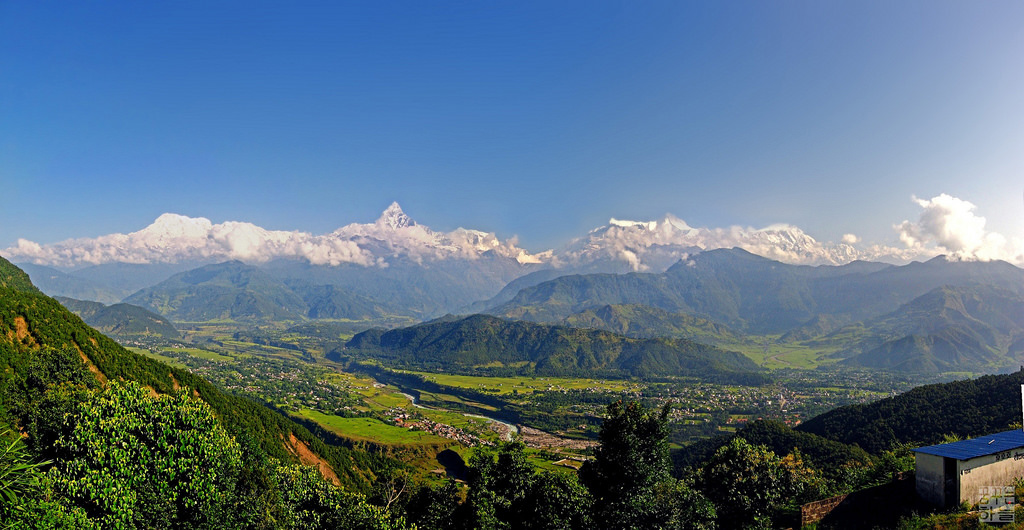Community Challenges to Capitalism at the Annapurna Eco-village in Nepal
Diverse alternatives to capitalism are emerging in myriad spaces and forms to create a more socially and ecologically sustainable world. Annapurna Eco-village in Astam, Nepal is but one example of a community attempting to decentre organisation and challenge capitalism’s role in orchestrating their everyday lives and experiences.
It can seem daunting and unrealistic to think there is a way to untangle the many disparate, exploitative threads and practices that have tied our collective future in a knot, with our wrists and democratic mechanisms firmly secured behind our back. But there are many stories of people and communities wriggling loose from the bonds of exploitation and reclaiming autonomy over how they live their lives, while protecting the environment and life systems upon which we are all dependent.
Resistance at the Annapurna Eco-village
Annapurna Eco-village is located in a small, rural town called Astam, approximately 35 km northwest of Pokhara in west-central Nepal, tucked up high in the Himalayas away from the hustle and bustle of the urban sprawl down below. On a clear morning, you’re gifted with 360° views of the snow-capped Himalayan peaks. I first heard about the eco-village from Sugham, one of the children who participated in my research in Pokhara, whose uncle is the director of the eco-village. They are part of the Adhikari family, which is a very prominent and influential upper-caste family in the region. We were talking about urbanisation in Pokhara when Sugham started telling me about how peaceful and beautiful this eco-village was, urging me to go and “see all the butterflies and beautiful flowers– it’s a paradise up there.”
In the Photo (above): Astam, Nepal. Photo Credit: Katherine Baxter
To reach this place is a journey. You can either take a taxi or bus to drop you off at the base of a rather steep and anonymous mountain you must then wind yourself around for 4-5 hours. There is theoretically a road, but very few vehicles are able to make it up. It’s a difficult hike, especially if you’ll be staying for a while and have a pack to carry. There are faded wooden signs scattered along the narrow, damp trail through the jungle, and I found myself lost more than once, having to retrace my steps and return to the last point of certainty. When I first arrived I found everyone quite upset because one of the two resident dogs, Tashi and Delek, had been eaten by a tiger the previous night. Now the sole remaining dog, Tashi, was walking around with a 6-inch nail-studded collar to keep the tigers from his neck, which gave me a moment’s pause, as I had just walked for hours alone through the jungle.
Video Credit: Logged On
I spent the next several weeks learning the very sophisticated ways in which this place had been able to bring together different knowledges, or sets of everyday practices, with the intention of removing themselves from a reliance on market-based production and distribution. Through extensive, collective efforts to self-sufficiently and sovereignly meet their community’s demands for (1) food (2) renewable energy (3) clean water and (4) alternative livelihood options, Annapurna Eco-village is an example of a bottom-up approach to rejecting dominant processes of proletariat and market-based production and distribution in the region. It is through powerful synergies between different knowledges and technologies—indigenous and scientific—that this community has been able to achieve this sovereignty, and it is through the integration of these knowledge synergies into the local public school that this community seeks to maintain its self-sufficiency and active rejection of capitalist forces. However, challenges of co-optation are also an important consideration as the eco-village struggles to make ends meet within the dominant market framework in Nepal, while at the same time trying to hold onto their autonomous removal from the market. This positioning continually puts pressure upon this community to make small, profit-oriented compromises, mostly in the form of eco-tourism, in order to keep the larger dream of creating and maintaining an alternative, ecologically sustainable community alive.
(1) Food Practices
One of the most significant ways they’re doing this is through localizing food knowledge and practices. Everything eaten and consumed is grown and/or produced in this village, which is remarkable. This is facilitated by extensive indigenous agricultural knowledge sharing that has been passed on through generations (i.e. soil cultivation, seasonal variations, edible/usable plant species, food storage techniques), coupled with new knowledges and technologies (all organic) that have allowed them to optimize their crop yields (i.e. alternative forms of pesticide such as diluted cow urine). This localized, autonomous food system has been cultivated through intensive community cooking classes, seasonal diets, reduced consumption, and more. The eco-village is entirely vegetarian, but does rely on a small number of cows, goats and chickens for eggs and dairy products.
(2) Renewable Energy
Access to reliable energy and/or electricity is quite uncommon in Nepal. Even in urban Kathmandu and Pokhara, there are regular power outages and thus the supply of electricity from the central grid is sporadic. This significantly complicates people’s ability to carry out their daily tasks and interrupts livelihoods, particularly as there is no way to know when the power will be on and when it will switch off. For a small café in Pokhara, for instance, not having access to electricity for an entire evening can lose them a significant amount of income as they aren’t able to light the room and it’s difficult to prepare meals over a small gas stove. Many people rely on gas as an alternative, and there are backup generators in some of the higher income neighborhoods, but for most everyone else this uncertainty is a reality of everyday life with significant consequences on their ability to make ends meet.
To mitigate these dependencies and consequent fragilities, the eco-village sought to gain control over their energy sources by localising them. The two principle sources of energy at the eco-village are biogas and solar. This sophisticated fusion of alternative, renewable energy systems coupled with conservative use allows this community complete energy autonomy.
(3) Clean Water
Furthermore, the Astam community has worked to gain access to and control over clean, non-contaminated water. Water quality and contamination is a huge issue throughout Nepal. Through connections of one of the community members to a few eco-engineers in Japan, the eco-village learned how to implement a very easy water filtration system called ‘Japanese sand-water filtration’ throughout the community. This essentially takes particular types of sand from the nearby hills with different granular properties and filters the water through it at various layers. They have been able to secure very large storage containers to hold the filtered water for later use to account for changing rainfall patterns.
(4) Alternative Livelihoods
Another crucial aspect of the success of the Annapurna eco-village is its ability to provide alternative livelihood options for members of the community, helping to remove them from their dependency on wage labor, which often leads to very distant and exploitative working conditions. I spoke to many former migrant workers who had left the village and their families to earn an income in Dubai, Malaysia or elsewhere, requiring them to go into crippling debt to do so. This was the only way they felt they could make money in order to purchase basic goods and pay their children’s school fees. The eco-village enabled these workers to return to Astam by providing an alternative livelihood option and minimizing income needs. Basanta (pictured in the red t-shirt below), for example, had been away working in Malaysia for six years in horrible conditions: more than 14 hours a day in 40-Celsius heat. He now works as the on-site chef for all the visitors after taking a cooking class that utilized his extensive knowledge of local food growing practices.
In the Photo (above): Japanese Sand-water filtration system being used to filter and provide clean water to the Annapurna Eco-village community. Photo Credit: Katherine Baxter
Sustainability through Local Integration
Finally, to combine all of this together in a way that is structurally sound and firmly rooted, community leaders (both men and women*) have integrated these technologies and the rationale/justification for their use into the local public school. This school had a computer lab, internet and widespread access to information, which they had secured through a grant from someone who had previously visited the eco-village and supported its vision. In a way, it was a very concrete example of communitarian-cosmopolitanism, where bodies and physical needs were firmly localized, but minds and ideas were connected to the entire world.
In the Photo (above): The founder (center) of the Annapurna Eco-village and two local residents who have been able to return home from working abroad to be with their families in Astam, thanks to jobs provided by the Eco-village. Photo Credit: Katherine Baxter
Challenges of Co-optation
As rosy of a picture I may have painted of this community’s relative success in creating a workable alternative, challenges of co-optation are also an important consideration as the eco-village struggles to make ends meet within the dominant market framework in Nepal, while at the same time trying to hold onto their autonomous removal from capitalism. This positioning continually puts pressure upon this community to make small, profit-oriented compromises, mostly in the form of ecotourism, in order to keep the larger dream of creating and maintaining an alternative, ecologically sustainable community alive. Most residents justify this as something that also supports knowledge exchange and synergies due to the fact that those who are attracted to visit such a place typically have some concern and interest in sustainability themselves, and therefore often have worthwhile insights to share. So this is seen as a necessary sacrifice and as a way of not falling into a mindset of exclusion and absolutism.
In the Photo (above): The Astam/Annapurna Local Public School. Photo Credit: Katherine Baxter
Obviously the ways that the Astam community has created this relatively autonomous space are unique to their particular circumstances. And this is not to say that no one who lives there ever sneaks down the mountain every now and again for a Coke and a pack of chips. But there might be lessons to take away from their example with regards to the importance of autonomy and self-sufficiency in the battle against the exploits of capitalism. There seems to be a great deal of potential in community initiatives that creatively and resourcefully combine different sets of daily food, water, energy and livelihood practices in ways that allow them to regain control over the means of production, while also maintaining their own way of doing things.
Recommended reading: “CONNECTING SUSTAINABILITY WITH THE SDGS”


















